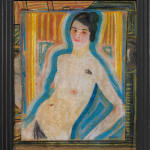Samuel Jessurun de Mesquita (1868–1944)
Samuel Jessurun de Mesquita was born in 1868 in Amsterdam. His father, a schoolteacher, died when Sam was only five years old. At fourteen, De Mesquita ambitiously applied to the Art Academy but was rejected. This setback did not deter him from pursuing his passion for art. He experimented with various techniques and mediums, ultimately becoming not only a remarkable artist and printmaker but also a talented teacher. His most famous protegé was M.C. Escher (1898-1972), with whom he shared a lifelong artistic and personal connection.
Unlike many of his contemporaries, De Mesquita was neither a traveler nor a bohemian. While other artists flocked to Paris at the turn of the century or later to New York, De Mesquita remained rooted in Amsterdam, working from his home at the Linnaeuskade.
As a non-religious Sephardic Jew, De Mesquita was not immune to the horrors of Nazi persecution. Although initially Dutch-Portuguese Jews were exempt from deportation, this protection did not last. In February 1944, De Mesquita and his family were removed from their home and transferred to transit camp Westerbork where they were forced to relinquish their valuables. Shortly after arrival, the sick and elderly, including Samuel and his wife Betsie, were deported. On 8 February 1944, the De Mesquitas were among 1,015 people loaded onto a train to Auschwitz, where they were murdered in the gas chambers upon arrival. Their only son, Jaap, was deported to Theresienstadt where he was killed on 30 March 1944.
With the annihilation of his family, De Mesquita’s life and artistic legacy seemed destined for obscurity. For decades, his name and work faded from public memory until 2005, when the Kunstmuseum in The Hague mounted a major retrospective, reigniting interest. Most of his works is preserved in Dutch museums, including the Rijksmuseum and the Kunstmuseum in The Hague.
An experimental artist, De Mesquita’s work defied the traditional hierarchies of the Dutch art world. He developed a unique “Sensitivist” style; drawings of strange, quasi-human beings that seemed to emerge directly from his imagination. These works anticipated the automatism of Surrealism, offering unfiltered expressions of his subconscious mind and evoking a world of unsettling and fantastical imagery.
De Mesquita was an artist of extraordinary duality, adept at creating images derived from reality and pure imagination. He masterfully bridged opposites, uniting reality and illusion, simplicity and complexity, order and chaos, fact and fiction, rationality and emotion, and the conscious with the unconscious. The present Nude from 1923, with its distinct drawn borders and vibrant background, closely resembles his large 1921 drawing of a boy in the Rijksmuseum.
Provenance
Sotheby Mak van Waay, Amsterdam, 29/30 September 1986, lot 206
Private collection, The Netherlands
Venduehuis, The Hague, 30 May 2013, lot 405
Private collection, The Netherlands



